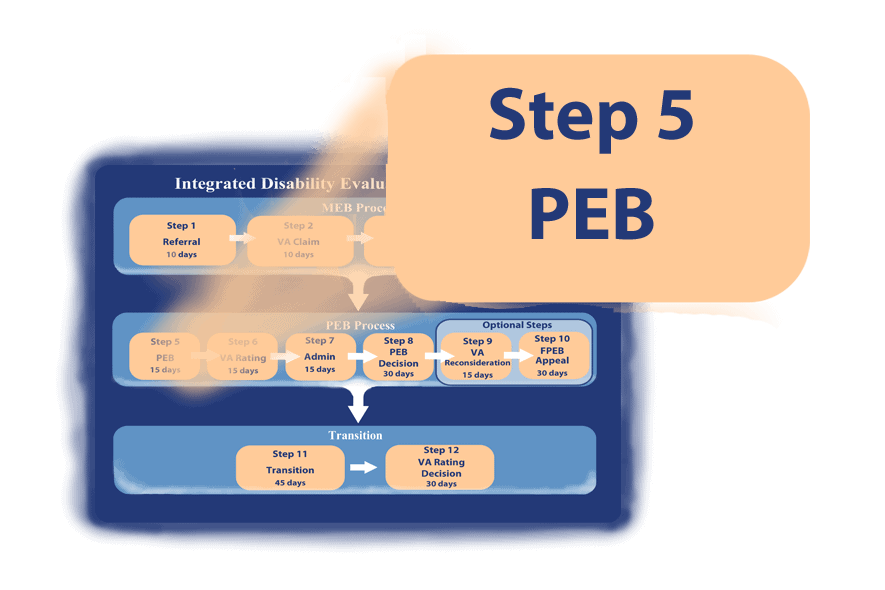The Physical Evaluation Board (PEB)

Topics:
The Informal Physical Evaluation Board
The Formal Physical Evaluation Board
Preparing for the Physical Evaluation Board

When a service member develops a condition that may make them Unfit for Duty, they are referred to the Integrated Disability Evaluation System (IDES). The fifth step in the IDES is the Physical Evaluation Board (PEB), which follows the Medical Evaluation Board (MEB).
The Physical Evaluation Board is a group of field grade officers or civilian equivalents that have the authority to decide what conditions make a service member Unfit for Duty and thus qualify for DoD Disability. All members, regardless of the military branch, hold the same decision-making power.
The Physical Evaluation Board is divided into two boards: the Informal Physical Evaluation Board (IPEB) and Formal Physical Evaluation Board (FPEB).
The entire process from the IPEB to the FPEB is referred to as the “PEB Process.”
The Informal Physical Evaluation Board
Once the Medical Evaluation Board (MEB) decides which of the service member’s condition are medically unacceptable, they submit their findings to the Informal Physical Evaluation Board.
The IPEB consists of at least two members, however, if they disagree on a case, then a third member is added for a majority vote.
It is the IPEB’s job to decide which, if any, of the service member’s service-connected conditions qualify for DoD Disability. To qualify, a condition must make the service member Unfit for Duty.
If the IPEB decides that none of the service member’s conditions are unfitting, then they either return the service member to full duty or return the service member to duty with an assignment limitation code (this could prevent the service member from deploying abroad, etc.).
If, however, the IPEB decides that at least one condition is unfitting, it then sends the unfitting conditions to the VA to be assigned Military Disability Ratings based on the rules of the VASRD.
Once the conditions are rated, the IPEB will decide whether to discharge the service member (medical separation or medical retirement) or place them on the Temporary Disability Retired List (TDRL).
Return to Top
The Formal Physical Evaluation Board
If the service member does not agree with the Informal Physical Evaluation Board’s decision, they can appeal to the Formal Physical Evaluation Board (FPEB) for reconsideration.
This Board consists of at least three members: a military officer acting as board president, a physician, and a line officer.
Once an appeal, or “rebuttal,” is received, the FPEB re-examines all of the evidence and the IPEB’s decision. After looking at the evidence, if the FPEB agrees with the original decision, a formal hearing will be scheduled. At the hearing, the service member will have the chance to present evidence (in person, or by videoconference or phone) and have witnesses testify if desired. If even after the hearing the Formal Physical Evaluation Board still agrees with the original decision, then it stands. The service member then has to pursue higher avenues of appeal, if desired.
If, however, the Formal Physical Evaluation Board disagrees with the original decision at any time in the process, it can adjust the decision as it sees fit. Any changes made override the original decision. If the service member is still unhappy with the changes that are made, they can then appeal to a higher authority.
Return to Top
Preparing for the Physical Evaluation Board
To ensure that your conditions are judged correctly by the Physical Evaluation Board, it is essential that you submit all the pertinent information to the Medical Evaluation Board (MEB) at the beginning of the MEB Process.
Find Your Conditions on our site so that you can make sure you submit all the evidence needed to properly rate your conditions.
Submitting the proper documentation is key!
Return to Top
FAQs
What is the Physical Evaluation Board (PEB)?
The PEB is the final step in the DoD Disability Process. This board decides if a service member's conditions are service-connected and whether they make them Unfit for Duty.
How long does the PEB Process take?
From the date of referral, the process takes roughly 1-2 months to complete.
How do I apply?
You do not apply to the PEB. Instead, you are referred to the MEB by your military physician when you have conditions that they feel make you Unfit for Duty. The MEB then forwards your case on to the PEB.
If I qualify for DoD disability, what benefits will I receive?
If the MEB and PEB both determine that your conditions are unfitting, you will either be medically separated or medically retired, depending on your disability rating. If you are medically separated, you will receive a one-time payment. If you are medically retired, you will receive a monthly payment as well as all other retirement benefits. You will also qualify to receive disability benefits from the VA.
How long does it take to receive my disability benefits?
You will begin receiving your benefits from the DoD within 2 months of separation.
How much money will I get monthly if I'm medically retired?
The exact amount you receive monthly is determined by your based pay and either your combined rating or your retirement percentage, whichever gives you a higher payment. You can find the full equation on our DoD Disability page.
Is the PEB part of the IDES?
Yes. Both DoD disability and VA disability are now combined through the Integrated Disability Evaluation System (IDES). This system allows for veteran to start receiving benefits from the both the DoD and the VA as soon after discharge as possible.
What is the purpose of the PEB?
The PEB's purpose is to determine which of the service member's conditions are service-connected and make them Unfit for Duty. They then assign ratings for DoD Disability based on the VA's rating decisions.


